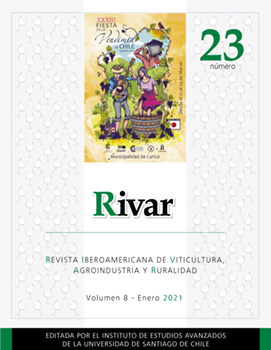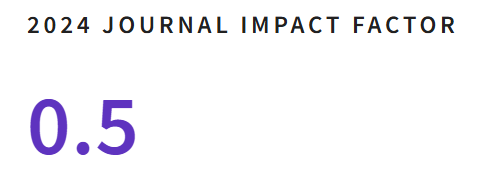Yerba Mate Party in South America: Argentina, Brazil and Paraguay (1961-2018)
DOI:
https://doi.org/10.35588/rivar.v8i23.4959Keywords:
customs, traditions, festivals, rural communities, agricultural products, religion, BarrosoAbstract
The proposal is to examine the socio-economic, symbolic and identity implications of the International Yerba Mate Party. The festival constitutes a space for regional integration by bringing together three countries: Argentina, Brazil and Paraguay; particularity that locates the celebration in a setting of cultural construction, with a unique mix of idiomatic sounds and customs that make the yerbatera basin a historical region that transcends the borders of national states. The enhancement of the ancestral heritage represents the slogan of the show that pays homage to the crop and tries to make visible the work of the producer represented under the figure of the settler. The town of Apóstoles in the province of Misiones (Argentina) is the scene of this annual celebration. The place of performance constitutes in itself a cultural expression surrounded by a symbolic halo linked to yerba mate, immigration and colonization. In addition to the reasons given, the interest of this work is to focus on the importance of this popular festival for the economy, noting the place it occupies on the agenda of the States involved and other members of civil society.
Downloads
References
Alves, VM. (2013). A Arte popular e nação no Estado Novo. A política folclorista do Secretariado de Propaganda Nacional. Lisboa, Imprensa das Ciências Sociais.
Barros, J. y Costa, SM. (2002). Festas e tradições portuguesas, Janeiro. Lisboa, Círculo de Leitores.
Cabral, JP. (1981). “O pároco rural e o conflito entre visões do mundo no Minho”. Estudos Contemporâneos 2(3): 75-100.
Coelho, AB. (2019). Comunas ou concelhos. Lisboa, Caminho.
Coelho, MHC. (2006). “O Poder Concelhio em tempos medievais - o ‘deve’ e ‘haver’ historiográfico”. Revista da Faculdade de Letras HISTÓRIA III(7): 19-34.
Costa, F. (2016). Do material ao imaterial. Procissões, festas e romarias no Almanach de Lembranças (1851-1932). Porto, Universidade do Porto.
Dias, AJ. (1990). “Uma introdução histórica à antropologia portuguesa”. En Dias, AJ. Estudos de Antropologia. Vol. I. Lisboa, Imprensa Nacional e Casa da Moeda: 2013-2229.
____. (1955). “Algumas considerações acerca da estrutura social do povo português”. Revista de Antropologia 3(1): 1-20.
Fontes, A. (2014). Etnografia Transmontana Crenças e Tradições de Barroso. Vol. I. Lisboa, Âncora.
Herculano, A. (1875). História de Portugal. 8va edición. Lisboa, Aillaud & Bertrand.
Hespanha, AM. (1982). História das Instituições. Épocas Medieval e Moderna. Coimbra, Livraria Almedina.
Leal, J. (2016). “A antropologia em Portugal e o englobamento da cultura popular”. Sociologia & Antropologia 6(2): 293-319. DOI https://doi.org/10.1590/2238-38752016v621
____. (2010). “Usos da cultura popular”. En Neves, J. (coord.). Como se faz um povo. Lisboa, Tinta da China: 125-137.
____. (2000). Etnografias portuguesas (1870-1970). Cultura popular e identidade Nacional. Lisboa, Publicações Dom Quixote.
Marx, K. y Engels, F. (1970). The German Ideology, Part One. Nueva York, International Publishers.
Mattoso, J. (1985). Identificação de um país. Ensaio sobre as origens de Portugal 1096-1325. Vol. I. Lisboa, Estampa.
Mauss, M. (1990). The Gift. The Form and Reason for Exchange in Archaic Societies. Londres, Routledge.
Mazoyer, M. y Roudart, L. (2006). A History of World Agriculture: From the Neolithic Age to the Current Crisis. Nueva York, Monthly Review Press.
Melo, D. (2001). Salazarismo e cultura popular (1933-1958). Lisboa, Imprensa de Ciências Sociais.
Neto, SM. (1997). “A persistência senhorial”. En Mattoso, J. (dir.). y Magalhães, JR. (coord.). História de Portugal, No Alvorecer da Modernidade. Lisboa, Estampa: 152-161.
Oliveira, EV. de (1984). Festividades Cíclicas em Portugal. Lisboa, Publicações Dom Quixote.
Ribeiro, O. (1998). Portugal O Mediterrâneo e o Atlântico. 7ma edición. Lisboa, Livraria Sá da Costa.
Rocha, JA. (2019). “Continuidade e mudança nas festas de São Sebastião em Barroso”. Revista Memória Rural 2: 124-145.
Sinclair, TR., y Sinclair CJ. (2010). Bread, Beer and the Seeds of Change. Agriculture’s Imprint on World History. Wallingford, CABI.
Soares, M. (2019). “Simbólica religiosa de Trás-os-Montes: olhares transversais e perspetivas cruzadas”. Revista Memória Rural 2: 114-123.
Sobral, JM. (2007). “O outro aqui tão próximo: Jorge Dias e a redescoberta de Portugal pela antropologia portuguesa (anos 70-80 do século XX)”. Revista de História das Ideias 28: 479-526.
Sousa, BV. (2009). “I Parte – Idade Média (séculos XI-XV)”. En Ramos, R. (coord.). História de Portugal. 7ma edición. Lisboa, A Esfera dos Livros: 17-196.
Souza, RL. (2013). Festas, procissões, romarias, milagres: aspectos do catolicismo popular. Natal, IFRN.
Stocking, GW. (1982). “Afterword: A View from the Center”. Ethnos 47(1-2): 172-186. DOI https://doi.org/10.1080/00141844.1982.9981237
Tiza, AP. (2019). Inverno Mágico Ritos e Mistérios Transmontanos. Vol. II, 2da edición. Lisboa, Âncora.
____. (2015). Inverno Mágico Ritos e Mistérios Transmontanos. Vol. I, 2da edición. Lisboa, Âncora.
Torga, M. (1978). Libertação. 4ta edición. Coimbra, Coimbra Editora.
Valério, N. (coord.). (2001). Estatísticas Históricas Portuguesas. Vol. I. Lisboa, INE.
Zeder, MA. (2011). “The Origins of Agriculture in the Near East”. Current Anthropology 52(S4): 221-235.









